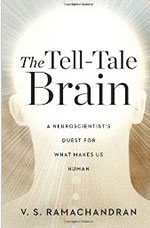The Tell-Tale Brain
 |
|
| Author | Vilayanur S. Ramachandran |
|---|---|
| Language | English |
| Subject | neuroscience |
| Genre | non-fiction |
| Publisher | W. W. Norton & Company |
|
Publication date
|
January 17, 2011 |
| Pages | 357 |
| ISBN | |
The Tell-Tale Brain: A Neuroscientist's Quest for What Makes Us Human is a 2010 nonfiction book by V. S. Ramachandran that explores, from a neurological viewpoint, the uniqueness of human nature. Ramachandran explores various aspects of visual perception and cognition to argue that humans are unique among species. For example, he notes that although animals show cortical remapping after the loss of a limb, the plasticity seen in the human brain (after amputation) is much more dramatic.
Ramachandran discusses seven main concepts which define the human aspect of self and how each may be disrupted by a specific neurological disorder. The concepts are: unity, continuity, embodiment, privacy, social embedding, free-will, and self-awareness.
Tell-Tale Brain was on the New York Times best-seller list (Number 32 on the Hardcover Nonfiction list) and received mostly highly positive with some exceptions. The book won the 2010 Vodafone Crossword Book Award (Non-Fiction).
In a review for Cognitive Neuropsychiatry (July 11, 2012) Professor Peter Brugger (Neurology, University Hospital, Zurich) criticized the Tell-Tale Brain as a pop-neuroscience book that provides vague answers to big questions. In the same issue of Cognitive Neuropsychiatry V.S. Ramachandran answered Brugger's criticism in an Author Response. Ramachandran argues that Brugger's approach to science has been focused on only a few topics and that he (Ramachandran) has taken a much broader approach. Ramachandran states that "I have --for better or worse-- roamed the whole landscape of visual perception, stereopsis, phantom limbs, denial of paralysis, Capgras syndrome, synaesthesia, and many others."
Oliver Sacks writes “No one is better than V. S. Ramachandran at combining minute, careful observation with ingenious experiments and bold, adventurous theorizing. The Tell-Tale Brain is Ramachandran at his best, a profoundly intriguing and compelling guide to the intricacies of the human brain.”
Norman Doidge, M.D., author of The Brain That Changes Itself praised the book by saying:“Ramachandran is the modern wizard of neuroscience. In The Tell-Tale Brain, we see the genius at work, tackling extraordinary cases, many of which mark turning points in neuroscientific knowledge. We see him hypothesizing, experimenting, failing, having epiphanies, experimenting, succeeding. In this utterly entertaining account, we see how these fascinating cases fit together, and how he uses them to explain, from a Darwinian point of view, how our brains, though evolved from those of other animals, become neurologically distinct and fundamentally human.”
...
Wikipedia
